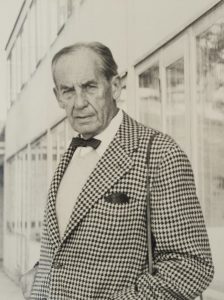
A design-historical overview
Walter Gropius
(1883-1969)
Architect and Director of Bauhaus
As one of the first schools of design and form, the Bauhaus had an enormous influence on the fields of furniture design, art, architecture and culture. Founded in 1919 by Walter Gropius, the school bore the official name “State Bauhaus in Weimar”. The basic idea of the Bauhaus was to abolish the separation between art and manufacturing. This was to be achieved by turning to craftsmanship as the basis of all artistic creation.
In the first years Gropius appointed the painter Lyonel Feininger, the sculptor Gerhard Marcks and the painter Johannes Itten as teachers at the institute. In the following years, in addition to the establishment of further workshops, the teachers Paul Klee, Oskar Schlemmer, Lothar Schreyer as the new head of the stage department, Marcel Breuer and the painter Wassily Kandinsky followed.
At April 1925, the Bauhaus was formally dissolved due to politically motivated harassment in the form of cuts in grants
At almost the same time, however, Walter Gropius and the teaching staff made efforts to find a new location. In the same year the Bauhaus was taken over as the municipal school of Dessau. One year later, the school’s university character was accredited. Now the training corresponded with a course of study that could be completed with a Bauhaus Diploma. In the same year, the Bauhaus GmbH was founded, which was intended to market the designs and licenses of the Bauhaus school commercially.
Ludwig Mies van der Rohe became the new director of the Bauhaus School in 1930. He aimed to keep the school out of public discussions through his apolitical leadership. However, when the NSDAP was elected the strongest party the following year, the school became more and more a centre of attention. In its appeals, the NSDAP demanded the cancellation of subsidies and the demolition of the Bauhaus buildings. Mies van der Rohe therefore decided to remove the school from the NSDAP’s sphere of influence and to continue it as a private institution in Berlin. At the end of 1932 the school moved to a building in Berlin-Steglitz. Barely half a year later the building was searched by the police, 30 students were arrested and the school was sealed. In the following years, many Bauhaus teachers, among others Walter Gropius, Lászlo Moholy-Nagy and Marcel Breuer, emigrated to Great Britain.
In 1996, the Bauhaus building in Dessau, which had been used by the “Bauhaus Dessau – Centre for Design” since 1986, was included in the UNESCO World Cultural Heritage list. Today it is the headquarter of the Bauhaus Dessau Foundation, which was established in 1994.
